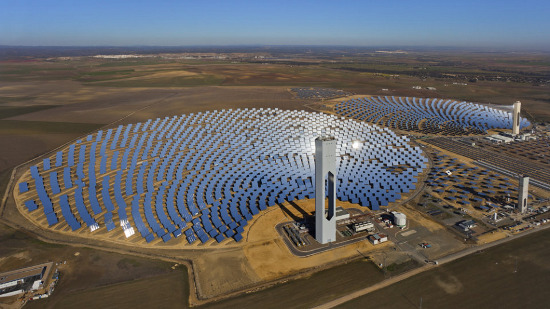Future electricity production technologies
Aiming to reduce greenhouse gas emissions by 80% compared to 1990, the world is looking for new, feasible and sustainable solutions.
The following eight new power generation technologies are considered excellent candidates for the above target and are expected to become not only realistic but also 'massive' in 2050.
The first is that concentrated solar thermal technology becomes popular in the near future. Currently, solar power capacity has only reached 12.4GW, but by 2050 it can increase to 2,000GW. Focused solar thermal technology uses a huge array of mirrors to generate heat and electricity.
In Northeast Los Angeles, the United States has a Sierra factory that uses this technology, using 24,000 mirrors with a total area of 20 acres, which can produce 6,400 MW. In the future, there will be at least 5 plants of this type built in the US.
The second is hydrodynamic power production technology. Hydropower is considered a clean energy source but the contribution is still relatively small. For example, hydroelectricity in the US only supplies about 7% of electricity demand. It is now possible to produce 31 GW and by 2050 it can be increased to 67GW. The most feasible technology is hydrodynamic technology, which produces electricity from the driving force of free flowing water.

A solar power plant in France.(Photo: gizmodo.com)
The first project under this technology is being developed in Houston, USA called Hydro Green Energy (HGE). Like a wind turbine, the plant produces electricity by using a high-speed, three-blade rotary fan about 4 meters long, like a wave power plant in Europe, but different from One-way water flow. The cost of producing electricity using this technology is cheaper than the cost of producing wind power, only about 4-7 cents / kwh compared to 10 cents / kwh.
The third is electricity production technology using biofuels. Currently ethanol is considered quite popular but in the future people will use more energy-rich organic materials such as sugarcane, algae, and waste water to produce the fuels used for delivery. information and electricity industry. The world currently produces about 643,000 biofuel tanks a day and can increase to 3.4 million barrels a day by 2050.
Fourth is the perfect biofuel production technology. A team of scientists at Pennsylvanian University, USA, is working to produce a perfect biofuel that does not pollute the environment. To produce this fuel, they studied the process of creating methanol, the main compound found in natural gas.
Through research, scientists found that the mechanism of producing methane is very simple, including water and carbon dioxide (CO 2 ) that are confined to electric current. Based on this principle, people will build a fuel cell containing methanogens and when there is an electric charge, it will produce a burning fuel, capable of neutralizing carbon, so it will not release gas. discharged into the environment.
Fifth is electricity production from ocean waves and tides under the ocean. According to calculations by scientists, oceanic electric farms in the Pacific region are very potential, each year can produce over 900 GW and currently in Norway, people are building a project. The test was named Hywind, using a 2.3 MW turbine, weighing 152 tons, installed at a depth of 65m on a fixed floor under the continental shelf.
Sixth is safe nuclear power production technology, completely free of carbon. At present, people produce 372 GW of this material, and by the middle of the 21st century it can be increased to 700 GW thanks to the new generation of atomic technologies, which is generation III + technology: using water design turbochargers; Generation IV: using gravel layer technology and generation V: using a mobile wave reactor.
Saturday is geothermal energy technology. One of the most abundant geothermal energy countries in the world today is Iceland. It is now possible to produce about 10 GW of geothermal electricity, which is expected to increase to 700 GW by 2050.
Eighth is the technology to produce clean electricity from fossil fuels. The world currently produces 1,460 GW of electricity from fossil fuels such as oil, gas or coal, which can be increased to about 3,830 GW by 2050 using new technologies to turn carbon into cement. The principle of operation of this technology is very simple, according to which people will bring emissions from thermal power plants using gas or coal through the sea layer. CO2 and pollutants in the above emissions will combine with magnesium and calcium in the sea water to create a new material like limestone, very suitable for cement industry, concrete or asphalt.
- 3 technologies trusted by Bill Gates will save the world
- Electricity production by artificial leaves
- Artificial meat 'crowned' next 2 years?
- 7 fascinating technologies on future cars
- The era of home fuel production
- Reduce thirst for electricity with coconut
- Future technologies will be popular in 2025
- The new invention could turn urine into electricity
- 5 future mobile technologies
- Korea and the United States invented carbon fiber that can produce electricity
- Russia promotes the construction of a power station from the universe
- Germany set the record for producing the most solar electricity in the world
 Is the magnetic North Pole shift dangerous to humanity?
Is the magnetic North Pole shift dangerous to humanity? Washington legalizes the recycling of human bodies into fertilizer
Washington legalizes the recycling of human bodies into fertilizer Lightning stone - the mysterious guest
Lightning stone - the mysterious guest Stunned by the mysterious sunset, strange appearance
Stunned by the mysterious sunset, strange appearance